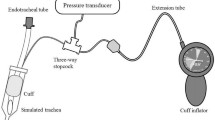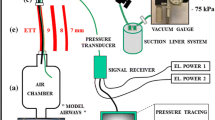Abstract
Objective. Flow through an endotracheal tube (ETT) causes a pressure loss across the tube. This loss results in a difference between pressure measured at the airway and pressure measured in the trachea. This difference can lead to errors when calculating pulmonary mechanics and when setting ventilators. We have tested a method of estimating tracheal pressure from the pressure in the ETT cuff.Methods. Pressure transducers were placed in the proximal ETT connector, in the trachea, and in the ETT cuff (through the inflation port). Instantaneous periods of zero flow, detected with a flow meter, were used to calculate the slope and offset of the line relating cuff pressure to tracheal pressure. The system was tested on the bench using a ventilator and lung simulator and in 2 dogs and 5 pigs. Tests were performed at various cuff pressures, trachea diameters, ETT sizes, respiratory rates, tidal volumes, and airway obstructions. Results. In bench tests, our estimate of tracheal pressure was within −4.0±2.6% of the actual tracheal pressure (mean = standard deviation [SD]). In animal tests, our estimation of tracheal pressure was within −0.6±5%. In all bench test measurements and in 40 of 42 animal measurements, the error was less than 1 cm H2O.Conclusions. The cuff estimation technique gives real-time, continuous, noninvasive tracheal pressure measurements in intubated animals with cuffed ETTs.
Similar content being viewed by others
References
Bolder PM, Healy TEJ, Bolder AR, et al. The extra work of breathing through adult endotracheal tubes. Anesth Analg 1986; 65: 853–859
Banner MJ, Kirby RR, Blanch PB, Layon AJ. Decreasing imposed work of breathing to zero using pressure support ventilation. Crit Care Med 1993; 21: 1333–1338
Martin LD, Rafferty JF, Wetzel RC, Giola FR. Inspiratory work and response times of a modified pediatric volume ventilator during synchronized intermittent mandatory ventilation and pressure support ventilation. Anesthesiology 1989; 71: 977–981
Banner MJ, Blanch PB, Kirby RR. Imposed work of breathing and methods of triggering a demand-flow, continuous positive airway pressure system. Crit Care Med 1993; 21: 183–190
Koska J, Kelley E, Banner MJ, Blanch P. Evaluation of a fiberoptic system for airway pressure monitoring. J Clin Monit 1994; 10: 247–250
Guttmann J, Eberhard L, Fabry B, et al. Continuous calculation of intratracheal pressure in tracheally intubated patients. Anesthesiology 1993; 79: 503–513
Author information
Authors and Affiliations
Rights and permissions
About this article
Cite this article
Wilder, N.A., Orr, J. & Westenskow, D. Evaluation in animals of a system to estimate tracheal pressure from the endotracheal tube cuff. J Clin Monitor Comput 12, 11–16 (1996). https://doi.org/10.1007/BF02025305
Received:
Revised:
Accepted:
Issue Date:
DOI: https://doi.org/10.1007/BF02025305




